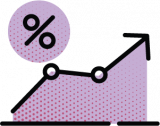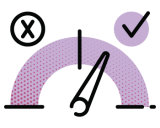Financial position
One of the factors used to determine the financial position of Philips Pensioenfonds is its funding ratio. If a pension fund has a funding ratio of 100%, this means that its assets exactly cover its existing pension liabilities. A series of financial rules laid down in the Financial Assessment Framework (Financieel Toetsingskader) have been used to define the following types of funding ratios:
Quarterly report
| Attachment | Size |
|---|---|
|
15 December 2025
Every quarter you can read in this report (in Dutch) how Philips Pensioenfonds is doing financially. |
407.71 kB |
Current funding ratio
The current funding ratio reflects the value of the pension fund’s assets as a proportion of the pension liabilities (all pensions payable now and in the future).
At 30 September 2025, Philips Pensioenfonds had an actual funding ratio of 127.2%.
Policy funding ratio
Another way of calculating the funding ratio that is less subject to daily fluctuations is the policy funding ratio. The policy funding ratio is calculated by taking the average of the actual funding ratios over the past twelve months. By law, pension funds are required to use their policy funding ratio for deciding on various matters, for example indexation. The policy funding ratio is also used for other purposes, including to establish whether the pension fund’s buffers are sufficient.
At 30 September 2025, Philips Pensioenfonds had a policy funding ratio of 123.0%.
Required funding ratio
The required funding ratio is the minimum policy funding ratio that pension funds are required to have according to the law. If a pension fund’s policy funding ratio is at the same level as the required funding ratio, this means that it has the financial buffer required by law. The purpose of this buffer is to compensate for fluctuations in the value of the pension fund’s investments and liabilities. The required funding ratio varies from one pension fund to the next, and is determined largely by the pension fund’s investment policy: the higher the risks in the investment policy, the higher the required funding ratio.
At 30 September 2025, Philips Pensioenfonds had a required funding ratio of 115.4%.
| Amounts in millions of euros | ||||
| End of Q3 2025 | End of Q2 2025 | End of Q1 2025 | End of Q4 2024 | |
| Pension fund's assets |
17,799 |
17,608 |
17,533 |
18,516 |
| Pension liabilities |
13,993 |
14,274 |
14,525 |
15,097 |
| Current funding ratio |
127.2% |
123.4% |
120.7% |
122.7% |
| Policy funding ratio |
123.0% |
122.6% |
123.6% |
124.0% |
Latest developments
In the third quarter of 2025, the current funding ratio rose from 123.4% to 127.2%. Equity markets rose last quarter. This was partly due to the trade agreement that Japan and the EU concluded with the United States. This alleviated concerns that high import tariffs would significantly slow economic growth. The real estate portfolio also performed positively, contributing to the increase in the value of the total portfolio of fixed-income securities in the third quarter. Furthermore, the return on the fixed-income portfolio was also positive due to improved investor sentiment and the decline in interest rates in the United States in the third quarter.
Due to rising interest rates in Europe, the value of pension liabilities decreased. Together with the increase in total invested assets, this led to a 3.8 percentage point increase in the current funding ratio in the third quarter.
Related information
Is the information below interesting for you?

Indexation policy
We try to increase your pension every year. This is called 'indexation'. But indexation cannot be taken for granted. Do you want to know more about our indexation policy?
Go to Indexation policy
Funding ratio
This graph gives you an idea of the financial health of Philips Pensioenfonds.
Go to graph